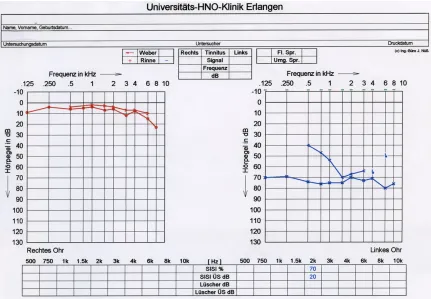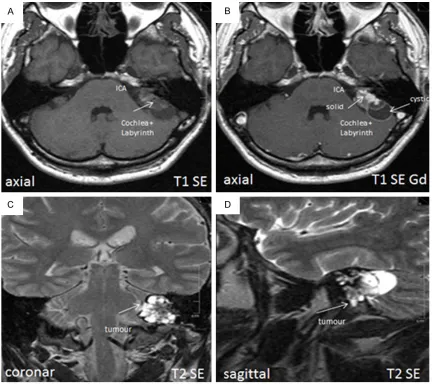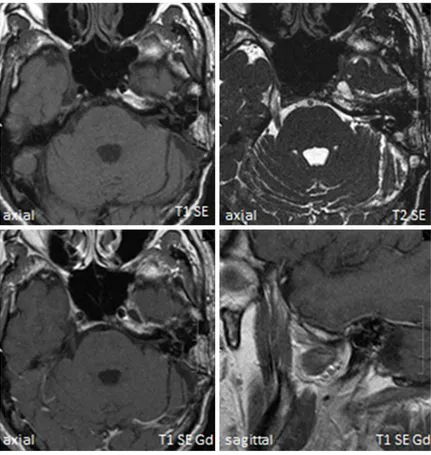Int J Clin Exp Pathol 2014;7(5):2641-2646 www.ijcep.com /ISSN:1936-2625/IJCEP1402037
Case Report
Sporadic endolymphatic sac tumor – a diagnostic and
therapeutic challenge
Julian Künzel1, Abbas Agaimy2, Joachim Hornung1, Michael Lell3, Oliver Ganslandt4, Sabine Semrau5, Johannes Zenk1
1Department of Otorhinolaryngology, Head & Neck Surgery, University Hospital of Erlangen-Nuremberg, Erlangen,
Germany; 2Department of Pathology, University Hospital of Erlangen-Nuremberg, Erlangen, Germany; 3
Depart-ment of Radiology, University Hospital of Erlangen-Nuremberg, Erlangen, Germany; 4Department of Neurosurgery,
University Hospital of Erlangen-Nuremberg, Erlangen, Germany; 5Department of Radiotherapy, University Hospital
of Erlangen-Nuremberg, Erlangen, Germany
Received February 11, 2014; Accepted March 29, 2014; Epub April 15, 2014; Published May 1, 2014
Abstract: Endolymphatic sac tumor (ELST) is a rare low-grade locally aggressive neoplasm of the inner ear that may occur sporadically or in the setting of von Hippel-Lindau syndrome. We herein present a case of sporadic ELST in a 39-year-old man, treated using an interdisciplinary approach (surgery + radiotherapy), with a 10-year follow-up. The patient presented with hearing loss of sudden onset. The treatment of choice for ELST is radical tumor resection, which is associated with a good long-term prognosis. Remission may last for years, but there may be local recur-rences, probably as a result of incomplete resection. Adjuvant radiotherapy is an option in case of recurrence and could be discussed after incomplete resection. The purpose of this report is to call attention to ELSTs, which are difficult to diagnose due to their rarity and variety of presentations.
Keywords: Lateral skull base, endolymphatic sac, hearing loss, vertigo, tinnitus
Introduction
Endolymphatic sac tumors (ELSTs) are rare low-grade papillary epithelial neoplasms (adeno-carcinomas) with a slow growth pattern. The
lesion was first described by Hassard et al. in
1984 [1]. The tumors show locally invasive and
infiltrative growth, but are not known to metas -tasize [1]. ELST has been published under dif-ferent names in the literature (Heffner tumor, aggressive papillary middle ear tumor, and low-grade adenocarcinoma of endolymphatic sac origin). ELST may arise sporadically or in von Hippel-Lindau (VHL) disease [2]. The symptoms (hearing loss with or without tinnitus, vertigo, impairment of cranial nerve function) and the physical and neuro-otologic examination and
imaging findings (computed tomography, mag
-netic resonance imaging) are not specific for tumors of the cerebellopontine angle (CPA) [3].
The final diagnosis can often only be reached through histopathological and immunohisto-chemical evaluation of the tumor specimen.
The differential diagnosis in tumors of the CPA includes paraganglioma, chondroid tumor, atyp-ical schwannoma, meningioma, and also rare entities such as aneurysm, hemangioblastoma, craniopharyngioma, and choroid plexus papillo-ma. According to a recently published literature review, some 150 cases of ELST have been reported to date [4]. We present here a further case of ELST that was treated using an interdis-ciplinary approach, with a 10-year follow-up period.
Case decription
Sporadic tumor of the endolymphatic sac
ed jugulotympanic paraganglioma, chondro-sarcoma, and ELST. A biopsy was taken via a transoccipital approach in October 2003. The histopathological examination revealed a low-grade epithelial neoplasm of the endolym-phatic sac, showing papillary and cystic struc-tures lined with bland cuboidal cells with low proliferative activity (Figure 3A, 3B). The tumor
cells in the superficial layers covering the papil -lae stained positively with antibodies against the epithelial marker pancytokeratin KL-1 (Figure 3C). There was a thin layer of CD31-positive endothelial cells beneath the epitheli-um (Figure 3D).
The ELST was treated on an interdisciplinary basis by head and neck surgeons and neuro-surgeons in December 2003. Surgery consist-ed of resection of the tumor via a transcervi-cal–transmastoid access route with neurona- vigation guidance. A macroscopically complete resection was achieved intraoperatively. The
final histological examination showed R1
tumor margin status in samples from the lat-medical history was unremarkable except for
allergic rhinitis. The clinical examination, includ-ing ear microscopy and testinclud-ing of cranial nerve
function, did not show any pathological find -ings. The initial treatment consisted of rheologi-cal infusion therapy carried out by his otologist. Readmission for further diagnostic work-up was recommended if no improvement followed this. In September 2003, the patient presented again due to persistent hearing loss, with no further neuro-otologic symptoms.
Magnetic resonance imaging (MRI) was
per-formed and identified a large, lobulated lesion,
3.5 × 1.8 × 2.5 cm in size, with a heteroge-neous high signal intensity, on T2-weighted images and avid enhancement of the solid parts on T1-weighted images after injection of contrast medium into the retrolabyrinthine tem-poral bone. Computed tomography (CT) showed a moth-eaten pattern of bone destruction. There was no peripheral thin rim of expanded bone, suggesting slow tumor growth. The lesion extended as far as the jugular foramen (Figure 2A-D). The differential diagnosis
[image:2.612.91.522.71.370.2]Sporadic tumor of the endolymphatic sac
eral petrous bone. The interdisciplinary tumor
board discussed and finally recommended
image-guided high-conformal stereotactic radiotherapy of the primary tumor region (with Novalis™), and this was carried out from January to April 2004, with a total dosage of 60 Gy. The course was uneventful except for a temporary slight left-sided paresis of the mar-ginal branch of the facial nerve postoperatively. The audiogram remained unchanged. A detailed neuro-otological examination showed
sufficient vestibular compensation. Genetic
testing showed no evidence of VHL gene muta-tion, so that a case of sporadic ELST must be assumed. The latest MRI follow-up examination was performed in April 2013, showing no signs
of tumor recurrence (Figure 4) or treatment side effects. At the time of writing, the patient had been tumor-free for 10 years, with com-plete facial nerve recovery.
Discussion
ELSTs are difficult to diagnose, due to their rar -ity and the wide variety of their presentations. Mean age of patients without von Hippel-Lindau (VHL) disease is reported to be 52 years, whereas in patients with VHL disease the mean age is reported to be 31 years [5]. Since ELST often occurs in the setting of VHL disease, patients with ELST should be screened for VHL gene mutation [2]. Patients characteristically
[image:3.612.91.523.70.454.2]Sporadic tumor of the endolymphatic sac
present with hearing loss, tinnitus, and vertigo. This combination of symptoms may mimic Ménière’s disease [6]. Sudden-onset deafness or severe hearing loss, as in this patient, has been the most common presenting symptom in most series, and early imaging therefore needs to be performed if no other cause is identi-
fiable.
The location of the tumor in the present case (the retrocochlear temporal bone) is suggestive for ELST. Osseous erosions with bone spicules, representing bone fragments rather than bone formation, have typically been found in ELSTs [7]. Peripheral bone expansion may be found as a sign of slow progression, differentiating the lesion from more aggressive tumors such as chondrosarcoma and from metastasis, which was absent in this case. Small ELSTs do not involve the jugular foramen, distinguishing
Figure3. HE staining in (A, × 200) and (B, × 400) showed prominent papillary fronds within a cystic structure. The papillae were lined by bland cuboidal cells. (C) The tumor cells in the superficial layers covering the papillae stained positively with antibodies against pancytokeratin KL-1. (D) A thin layer of CD31-positive endothelial cells was seen beneath surface epithelium.
this entity from paraganglioma. In contrast to
large tumors, which may demonstrate flow
voids as a sign of marked hypervascularity, this
finding is not typical for small lesions. However,
both small and large ELSTs show avid contrast enhancement.
resec-Sporadic tumor of the endolymphatic sac
Figure 4. There were no signs of tumor recurrence at the most recent magnetic resonance imaging follow-up exami-nation (in April 2013). Gd, gadolinium.
tion. Adjuvant radiotherapy is an option after incomplete resection [9], although there are no larger studies focusing on the role of adjuvant radiotherapy [5]. In advanced cases or in case of recurrence radiotherapy alone may be the sole option [5, 10].
In our case, the mass was large, destructed the mastoid process of the left petrous bone and extended to involve both the left medial
mas-toid as well as the middle ear, so it was difficult to extirpate surgically. The final histological
examination showed R1 tumor margin status in
Sporadic tumor of the endolymphatic sac
Conclusion
In patients with hearing loss, vertigo, tinnitus, or facial nerve paresis of unknown origin, ELST should be included in the differential diagnosis, and precise MRI examination plays a para-mount role in the diagnostic work-up. In sum-mary, the combined treatment of the sporadic ELST described here has led to local tumor con-trol with low morbidity for 10 years at the time of writing. Due to the lack of evidence in the lit-erature concerning the role of postoperative adjuvant radiotherapy of residual ELST, we like to point out that radiotherapy could also have been spared until progression, as there is no standard treatment recommendation. An inter-disciplinary treatment approach including sur-geons, radiologists, pathologists, and radio-therapists should be provided for patients with ELST in order to achieve local control of these
locally invasive and infiltrative tumors.
Disclosure of conflict of interest
None.
Address correspondence to: Dr. Julian Künzel, Department of Otorhinolaryngology, Head and Neck Surgery, University of Erlangen-Nuremberg, Walds- trasse 1, 91054 Erlangen, Germany. Tel: +49-(0)9131-8533156; Fax: +49-(0)9131-85-33833; E-mail: julian.kuenzel@gmx.net
References
[1] Hassard AD, Boudreau SF, Cron CC. Adenoma of the endolymphatic sac. J Otolaryngol 1984; 13: 213-16.
[2] Kim HJ, Hagan M, Butman JA, Baggenstos M, Brewer C, Zalewski C, Linehan WM, Lonser RR. Surgical resection of endolymphatic sac tu-mors in von Hippel-Lindau disease: findings, results, and indications. Laryngoscope 2013; 123: 477-83.
[3] Mukherji SK, Albernaz VS, Lo WW, Gaffey MJ, Megerian CA, Feghali JG, Brook A, Lewin JS, Lanzieri CF, Talbot JM, Meyer JR, Carmody RF, Weissman JL, Smirniotopoulos JG, Rao VM, Jinkins JR, Castillo M. Papillary endolymphatic sac tumors: CT, MR imaging, and angiographic findings in 20 patients. Radiology 1997; 202: 801-8.
[4] Virk JS, Randhawa PS, Saeed SR. Endolym-phatic sac tumour: case report and literature review. J Laryngol Otol 2013; 127: 408-10. [5] Sun YH, Wen W, Wu JH, Song JM, Guan H,
Wang KX, Xu MQ. Endolymphatic sac tumor: case report and review of the literature. Diagn Pathol 2012 Apr 2; 7: 36.
[6] Lee KJ, Kirsch CF, Lai C, Ishiyama A. Endolym-phatic sac tumor presenting with Ménière’s disease. Otolaryngol Head Neck Surg 2010; 142: 915-16.
[7] Bell D, Gidley P, Levine N, Fuller GN. Endolym-phatic sac tumor (aggressive papillary tumor of middle ear and temporal bone): sine qua non radiology-pathology and the University of Texas MD Anderson Cancer Center experience. Ann Diagn Pathol 2011; 15: 117-23.
[8] Hansen MR, Luxford WM. Surgical outcomes in patients with endolymphatic sac tumors. La-ryngoscope 2004; 114: 147-4.
[9] Balasubramaniam S, Deshpande RB, Misra BK. Gamma knife radiosurgery in jugular fora-men endolymphatic sac adenocarcinoma. J Clin Neurosci 2009; 16: 710-11.
[10] Hou ZH, Huang DL, Han DY, Dai P, Young WY, Yang SM. Surgical treatment of endolymphatic sac tumor. Acta Otolaryngol 2012; 132: 329-36.


